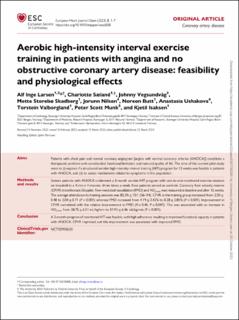| dc.contributor.author | Larsen, Alf Inge | |
| dc.contributor.author | Sæland, Charlotte | |
| dc.contributor.author | Vegsundvåg, Johnny Åge | |
| dc.contributor.author | Skadberg, Mette Storebø | |
| dc.contributor.author | Nilsen, Jorunn | |
| dc.contributor.author | Butt, Noreen | |
| dc.contributor.author | Ushakova, Anastasia | |
| dc.contributor.author | Valborgland, Torstein | |
| dc.contributor.author | Munk, Peter Scott | |
| dc.contributor.author | Isaksen, Kjetil | |
| dc.date.accessioned | 2024-01-17T09:58:37Z | |
| dc.date.available | 2024-01-17T09:58:37Z | |
| dc.date.created | 2023-08-18T08:33:26Z | |
| dc.date.issued | 2023 | |
| dc.identifier.issn | 2752-4191 | |
| dc.identifier.uri | https://hdl.handle.net/11250/3112078 | |
| dc.description.abstract | Aims
Patients with chest pain and normal coronary angiogram [angina with normal coronary arteries (ANOCA)] constitute a therapeutic problem with considerable functional limitation and reduced quality of life. The aims of the current pilot study were to (i) explore if a structured aerobic high-intensity interval training (HIT) program for 12 weeks was feasible in patients with ANOCA, and (ii) to assess mechanisms related to symptoms in this population.
Methods and results
Sixteen patients with ANOCA underwent a 3-month aerobic HIT program with one-to-one monitored exercise sessions on treadmill in a 4 min × 4 manner, three times a week. Four patients served as controls. Coronary flow velocity reserve (CFVR) transthoracic Doppler, flow-mediated vasodilation (FMD) and VO2max was measured at baseline and after 12 weeks. The average attendance to training sessions was 82.3% ± 10.1 (56–94). CFVR in the training group increased from 2.50 ± 0.48 to 3.04 ± 0.71 (P < 0.001) whereas FMD increased from 4.19 ± 2.42% to 8.28 ± 2.85% (P < 0.001). Improvement in CFVR correlated with the relative improvement in FMD (R = 0.45, P = 0.047). This was associated with an increase in VO2max from 28.75 ± 6.51 mL/kg/min to 31.93 ± 6.46 mL/kg/min (P < 0.001).
Conclusion
A 3-month program of monitored HIT was feasible, with high adherence resulting in improved functional capacity in patients with ANOCA. CFVR improved and this improvement was associated with improved FMD. | en_US |
| dc.language.iso | eng | en_US |
| dc.publisher | Oxford University Press | en_US |
| dc.rights | Navngivelse-Ikkekommersiell 4.0 Internasjonal | * |
| dc.rights.uri | http://creativecommons.org/licenses/by-nc/4.0/deed.no | * |
| dc.title | Aerobic high-intensity interval exercise training in patients with angina and no obstructive coronary artery disease: feasibility and physiological effects | en_US |
| dc.type | Journal article | en_US |
| dc.type | Peer reviewed | en_US |
| dc.description.version | publishedVersion | en_US |
| dc.rights.holder | Copyright 2023 The Author(s) | en_US |
| dc.source.articlenumber | oead030 | en_US |
| cristin.ispublished | true | |
| cristin.fulltext | original | |
| cristin.qualitycode | 1 | |
| dc.identifier.doi | 10.1093/ehjopen/oead030 | |
| dc.identifier.cristin | 2167811 | |
| dc.source.journal | European Heart Journal Open (EHJ Open) | en_US |
| dc.identifier.citation | European Heart Journal Open (EHJ Open). 2023, 3 (2), oead030. | en_US |
| dc.source.volume | 3 | en_US |
| dc.source.issue | 2 | en_US |

